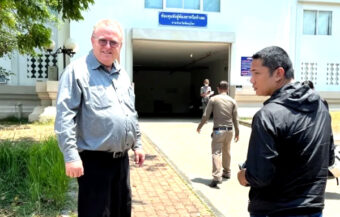Growth rates slashed again as Thailand looks unlikely to hit 3% growth this year while its neighbouring economies are growing at figures in excess of 6%. Aside from the Thai baht, the trade war and even household debt, the main problem is an intractable one. It is simple demographics which the Thai economy does not yet have the sophistication to overcome.
The World Bank on Thursday was increasingly pessimistic about Thailand’s economic growth rate for 2019 and 2020 downgrading both to 2.7% and 2.9% respectively. It means that Thailand now looks to be well behind other Southeast Asian countries as it contends with a growing list of problems that have made 2019 somewhat of an annus horribilis for Thai economic planners.

It now appears increasingly likely that the Thai government’s revised 3% growth target will not be attained this year as the World Bank on Thursday slashed its projected growth rate for the Thai economy from 3.7% to 2.7% even below the 2.8% recently suggested by the Bank of Thailand. The American based institution also projected only a marginally better performance for 2020 as it predicted a 2.9% growth rate.
Senior economist at the World Bank presented the revised data on Thursday showing a gloomier outlook
The figures were presented by a senior economist at the World Bank, Kiatipong Ariyapruchya, on Thursday. It is the third downgrade in the country’s prospects this year as the bank in April first adjusted the project growth rate to 3.8% followed by another cut in July. The bank official highlighted a staggering 5.3% contraction in exports as one of the main factors in the slow down as well as a 2.5% cut in the service economy.
Severe drought and flooding
The bank also pointed out that the country’s farming sector had been hit by the worst drought in 10 years. Of course, this was followed by severe flooding which a Bank of Thailand official warned the week before would serve to counter the initial phase of the government’s fiscal stimulus package in terms of GDP.
Thailand losing manufacturing facilities to ASEAN neighbours even as it gains from new supply chains
Another worrying trend observed by the IMF in recent reports is that while Thailand is gaining some manufacturing startups in the hardware tech sector in particular because of re-engineered supply chains brought about by the US-China trade war, many firms are also opting at this time to move production facilities to neighbouring countries such as Myanmar, Cambodia and Vietnam. The reason is the income trap.
Thai workers while not highly paid by international standards are so defined within the ASEAN region. The country is exhibiting the same profile as developed economies more like Japan with low inflation and a reliance on imported foreign labour to stay competitive in some areas of the economy while losing out to its low-cost neighbours in others.
Shrinking workforce with more elderly workers
Being competitive is also made increasingly difficult because of a shrinking workforce including many elderly workers working beyond retirement age. It is also now experiencing constraints with rising opportunity for workers in countries where Thai industry has traditionally sourced migrant labour.
What we are witnessing are the very real effects of demographics which even in the last few years of only moderately acceptable growth was acknowledged by economists as holding back the country’s potential.
Household debt noted by the World Bank and the IMF as a key issue to be addressed
Similarly, with the household debt problem which the IMF and World Bank this week acknowledged and encouraged Thailand’s central bank to continue to be active in monitoring. The Bank of Thailand Governor has plans to bring the chronic problem under control through stricter and broader lending criteria but has postponed a decision on this until the end of the year. Such a move would certainly hamper growth in the short term but at some point, the medicine will have to be administered.
Thailand’s consumer sentiment index is diving
On Thursday also, the University of the Thai Chamber of Commerce revealed that the kingdom’s consumer index continues to dive with the seventh consecutive drop in as many months since the scale of the slow down first emerged in March this year.
At 72.2 it is now well below the lowest point in that period which was 73.5 recorded in July 2016.
Government putting faith in the last quarter’s high tourist season to recover lost growth
The government is putting its faith in a strong tourist high season and the effects of economic stimulus measures to recover its 3% target by the end of the year. However, there is still strong concern within the tourism industry about the country’s tourism prospects this year despite the government’s publication of higher visitor numbers.
This week, hoteliers in Chiang Mai pointed out that the average occupancy rate of 60% for the July and August period was well below the normal figure of 80% achieved last year.
The figures were revealed by Ms La-Iad Bungsrithong who is the President of the Thai Hotels Association in northern Thailand.
Visitors in 2019 are staying for shorter periods according to Thai hoteliers on key locations
The comments were similar to hoteliers in Pattaya and Phuket in the summer. All pointed to the fall-off in Western, European and high spending type Chinese visitors. They also reported that tourists in particular from India were coming on micro-holidays spending 3 to 5 days in Thailand whereas the normal is just under 10 days and with high spending western visitors, the stay is even longer.
Fears of the baht breaking the ฿30 to the dollar barrier
Tourism industry sources are also expressing growing concern at the still strengthening baht with many warning of the danger of the Thai currency exceeding the psychological barrier of ฿30 to 1 US dollar.
World Bank detects a lack of public investment
The World Bank this week, in its review, pointed out that public investment by the government is below par so far in 2019 contributing to the gloomier outlook.
The bank called for the expedition by the government of spending in this area in particular with the Eastern Economic Corridor project which has itself been bedevilled by growing tensions between the Thai government and the main contractor for the high-speed rail link, Thailand’s huge and privately owned CP Group.
The contract for this key part of the project has been delayed. A deadline of October 15th was withdrawn by the Department of Transport this week following the resignation of board members of the state railway company.
Thailand bottom of the list when it comes to growth
In the meantime, the Thai economy is now at the bottom when it comes to economic growth in Southeast Asia for both this year and next year.
Thailand’s piers in ASEAN will still record growth rates above at least 5% this year. Economists are divided on the main cause of the deterioration. Much of it has been brought about this year by the US-China trade war but the underlying problem of demographics and household debt cannot be underestimated.
The impact of the spiralling baht this year has certainly impacted the country’s economy in the export and tourism sectors.
Bank of Thailand governor pushing ahead with the relaxation of outgoing capital controls
Despite comments from the World Bank’s Birgit Hansil in Bangkok on Monday that it will be difficult for the Bank of Thailand to rein in the appreciating baht, it is being reported that Bank of Thailand Governor Veerathai Santiprabhob is pushing ahead with his plans to relax outgoing capital controls and a range of calculated measures to this effect may be announced in the next 1 to 2 months.
World Bank country head for Thailand warns that curbing the baht will be difficult
‘The trends that drive Thai baht appreciation aren’t easy to combat by central bank policies,’ the World Bank country manager for Thailand said as she added that this was a sign of confidence in Thailand.
The comment by Ms Hansl and similar sentiments expressed by the IMF and last week by Fitch, the ratings agency, highlight the government’s strong sovereign position.
This week, both the IMF and the World Bank rightly singled out the Thai central bank for praise on its regulation and oversight of the country’s commercial banks but wanted to see more done to look at state-run financial institutions.
Demographics is the underlying and perhaps biggest economic inhibitor for Thailand
However, all agencies fail to address or remain rather aloof from the biggest problem that Thailand faces alongside increasing household debt. It is perhaps the biggest problem of all, demographics.
The same issue that is now severely impacting the once superlative German and Japanese economies and ultimately responsible the main driver of economic growth which is young people, young consumers and young workers.
This is one of the key reasons why Thailand’s neighbours are growing at a faster pace even with trade war storm clouds while Thailand has been left in the doldrums. There are others of course.
Thailand, because of decades of global and UN population control policies, now finds itself lacking in the most important resource of all, human resources. It is a blind spot for most commentators that should no longer be ignored.
Concerns also about ongoing political divisions
There is also a lingering concern that political divisions in Thailand have not gone away although the opposition’s signal this week not to defeat the government’s budget but rather a promise of no quarter in a debate on the issue was an encouraging sign. The country could do with more like it.
Further reading:
Thailand’s tax collectors facing falling income are readying to pounce on the internet next year
Opposition will not put the ฿3.3 trillion 2020 budget bill in danger but plans to scrutinise it
Central bank boss plans to loosen capital controls and decide on broader lending curbs by year’s end
Thai economy remains sound says Fitch the ratings agency as the baht’s surge may be over for now
Thailand’s new move to boost the birth rate and fight the negative impact of an ageing population


















